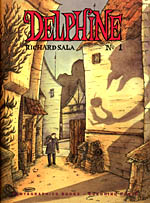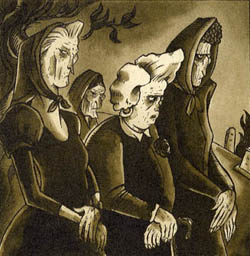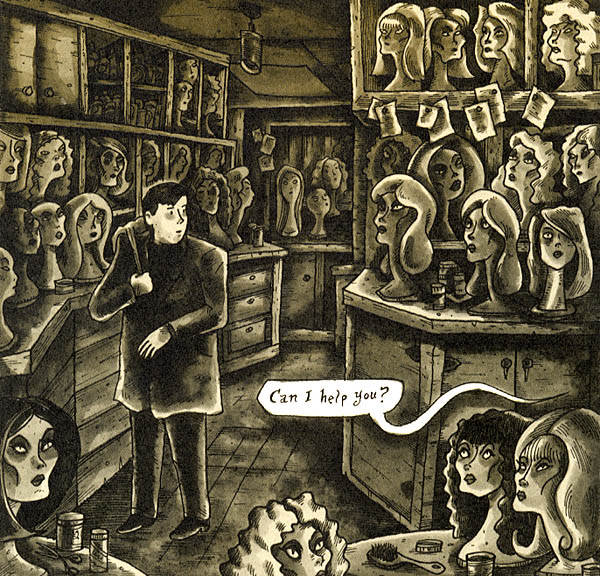 By Richard Sala
By Richard Sala
32 pages, two-color
Published by Fantagraphics Books
Richard Sala is the sort of creator whose works straddle all sorts of genres and classifications, but is always unmistakable. While his style has been refined and continues to evolve over the years, its off-beat, slightly-tilted-from-reality sensibility continues to remain as Sala’s hallmark. Delphine, Sala’s new series for the international Ignatz comic line, is no exception to that rule.
 A young man is looking for someone special. Her name’s Delphine, and the last he saw her, she was heading off to take care of her sick father. Now, given confusing directions and surrounded by unhelpful and bewildering people and places, finding Delphine may be so not much his primary goal, but instead to merely survive the madness that continues to assault him.
A young man is looking for someone special. Her name’s Delphine, and the last he saw her, she was heading off to take care of her sick father. Now, given confusing directions and surrounded by unhelpful and bewildering people and places, finding Delphine may be so not much his primary goal, but instead to merely survive the madness that continues to assault him.
Delphine is, in Sala’s own special way, a version of the famous Snow White fairy tale. It’s certainly a different rendition than what people have experienced before, though. Set in the modern day, this focus on the Prince Charming archetype character is disorienting and confusing—but in a good way. Sala is able to make the protagonist’s unease from the strange people and places around him very real and tangible; it simultaneously makes him human and easy to sympathize with, and also a real hero by being able to take so much of this strange near-abuse that is continually dished out onto his shoulders. Every time things begin to shift back to normalcy, Sala throws in a new piece of oddness that almost takes a second or two for the reader (and the protagonist) to really digest. And by the time you (and he) grasp that something is wrong, it’s too late. Delphine isn’t just oddness, though. There’s a love story buried here (and the shift to letting the “prince” and Delphine know each other from before is a smart one), and a mystery to boot. Sala’s taking the time to start fleshing out the past relationship is a nice break in the story, and really helps you understand his urgency in trying to find the missing Delphine. Likewise, the mystery on the location and fate of Delphine works because it provides a common thread to link the narrative together; it’s not a series of random events, but a quest that is hopefully progressing towards its target even as it continues to ask questions. It’s a sharp piece of writing, and a good first chapter to a longer story.

Sala’s art is unsurprisingly as strong as ever. The slightly larger, magazine dimensions of Delphine lets Sala’s art have a little more room to expand across the page, giving the reader a chance to get a good look at the carefully laid out lines that form the characters. Sala’s characters still have their trademark angular faces but there’s a slight softness on display here that wasn’t present in some of his earlier works, perhaps because of the greater detail provided the reader, perhaps because of the gentle ink washes that move across the page that gives the art additional depth and texture. When the main character first enters the wig shop, for instance, the extra shading lets Sala put more detail into the backgrounds, knowing that he can control the reader’s initial visual focus to latch onto our hero before fully soaking in everything around him. It’s a careful, deliberate usage of light and darkness that comes across excellently. This is a book that visually comes together perfectly, from background and secondary characters’s personal styles and expressions, to the slightly archaic lettering style that Sala carefully crafts. When the largest complaint one can come up with is that the full-color cover is so beautiful you almost wish the interiors got that sort of treatment—but not really because the shading is so beautiful as it is—it’s easy to see that this is probably the strongest work of Sala’s career to date.
The Ignatz line of books (co-published with Coconico Press) is an amazingly strong series, with releases like Ganges and They Found The Car a reason to celebrate. With Delphine #1, Sala has thrown down the gauntlet for future debuts. This is a real joy to read from start to finish, and I’m incredibly eager to devour the next installment. This is, ultimately, the sort of book that I can’t wait several years for an eventual collection. With high production values making a new issue something sharp to look at in its own right, each installment is a purchase I’m more than happy to make.
Purchase Links:
